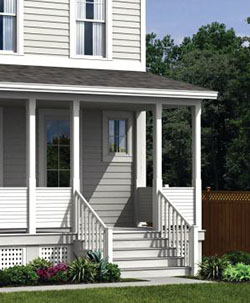Home Building Articles
No-MaintenanceHome Myth
January 07, 2010
Our virtual home designer and building scientist weigh in on defining true sustainability.

Related Articles
Save / Share
Glimpse the Future: The Home for the New Economy will debut exclusively online,
with narrated and photo-realistic virtual tours, at the 2010 International Builders'
Show and remain open through June 2010.
"The most sustainable home is one that you care enough to maintain over time," says
Miami-based residential designer Marianne Cusato. "The promise of a 'no maintenance'
home or product is a myth, and it actually undermines sustainability."
For Cusato, whose Katrina Cottage concept has become popular along the rebuilding
Gulf Coast, sustainability has less to do with a menu of energy- and resource-efficient
materials than it does with creating housing that the owners want to—and can—repair
and refinish to keep it fresh and performing well. "You can have all the green products
in the world, but if the house can't be maintained and wears out after 25 years
and has to be replaced, that's not sustainable," she says.
This relatively new angle on sustainability, shared by architects and builders who
appreciate a time when window panes could be replaced without buying a whole new
window, is a backlash against a generation of products and systems bent on relieving
homeowners of the burden of home maintenance.
That sentiment is echoed by building scientist Mark LaLiberte, who is partnering
with Cusato and building expert Fernando Pages to launch the Home for the New Economy,
a series of designs that deliver livable, adaptable, buildable, and sustainable
housing for a new economy of thrift, not excess. "Building science isn't a checklist,"
LaLiberte says, comparing the concept to green building. "It's an approach to building
that improves overall performance and considers the occupants while lowering costs."
While Cusato and her team obviously hope the Home for the New Economy series resonates
with builders and buyers on a mass-market scale (communities in upstate New York
and in South Carolina have already taken the plunge), she's also building a virtual
version of the concept (in cooperation with Builder) to help spread the word (to
pre-register, go to www.builderconcepthome2010.com ).
Simply, Cusato is hoping to rekindle the value of homeownership beyond price appreciation
and resale potential. "We need to get back to owners participating in their homes,
not just living in them," she says.